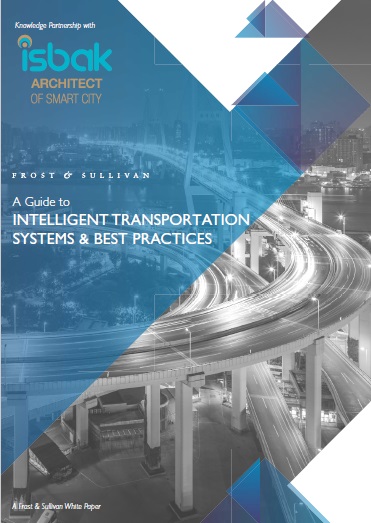Future cities are tackling transportation-related problems using an integrated platform that can centrally manage mobility, safety and the environment
LONDON – 19 December, 2017 – With increasing pressure on cities’ mobility infrastructures due to rising urbanisation, city governments all over the world are constructing new roads, bridges and tunnels, and using intelligent transportation systems (ITS), to mitigate transportation-related challenges and requirements. However, ITS implementation is costly as different technologies, platforms, and systems need to integrate into a single platform. Cybersecurity, data analysis, and connectivity will be critical to ITS success.
 Frost & Sullivan and ISBAK, a leading smart city solution provider, have recently released A Guide to Intelligent Transportation Systems & Best Practices. The white paper provides an in-depth analysis of transportation policies, implementation methods, best practices, and challenges for key cities, including New York, Singapore, London, and Istanbul. ITS is classified into different categories, including traffic management, public transportation, traveler information, pricing systems, commercial vehicle operations, emergency management, maintenance, and construction management.
Frost & Sullivan and ISBAK, a leading smart city solution provider, have recently released A Guide to Intelligent Transportation Systems & Best Practices. The white paper provides an in-depth analysis of transportation policies, implementation methods, best practices, and challenges for key cities, including New York, Singapore, London, and Istanbul. ITS is classified into different categories, including traffic management, public transportation, traveler information, pricing systems, commercial vehicle operations, emergency management, maintenance, and construction management.
To access the white paper please visit: http://frost.ly/22e
“The use of ITS will improve the quality of transportation in cities, contributing to the economic progress, and aid the establishment of smart cities,” said Frost & Sullivan Mobility Consultant Hikmet Çakmak.“Commuters, city management councils, citizens, and the environment stand to benefit from ITS implementation through better traffic flow, improved safety, lower transportation costs, increased business activity, and improved travel information.”
Singapore, London, New York, and Istanbul employ a variety of innovative mobility solutions to utilize existing roadways and reduce congestion and emissions efficiently. These include:
- The use of smart mobility in Singapore with the world’s first autonomous taxi called Robo taxi;
- London pioneering transportation operation data sharing with Transport for London committed to open data to serve the public transparently and to support the development of start-ups and small-to-medium size technology companies;
- New York City upgrading its existing intelligent traffic signal infrastructure to a more advanced system that uses RFID readers and cameras that are used to transmit real-time information to the world’s largest traffic management center; and
- Istanbul using different ITS components, such as cameras, traffic enforcement systems, detectors and Bluetooth sensors. Its adaptive traffic management system (ATAK) improves traffic by controlling traffic signals with real-time intervention. This is providing fuel and time savings equivalent to 37 million USD yearly.
“With the data collected from IoT devices in the city, such as cameras and sensors, we have reached the level of providing drivers and passengers with an active decision support system as opposed to a passive information system,” said ISBAK CEO Muhammed Alyürük. “ISBAK is currently designing all ITS technologies as an integrated part of a smart city.”
Since ATAK’s installation in 2013, there has been a 20% reduction in travel times, 30% decrease in delays, and an increase of 35% in average speeds. In the near term, ATAK is expected to provide:
- Better integration with Variable Message Systems, city congestion maps and direction maps;
- Green light corridor ability for emergency vehicles such as ambulance, police, and fire trucks; and
- Improvement in vehicle-to-vehicle systems by optimizing waiting times and increasing vehicle safety.
“ITS providers should seek out opportunities in emerging cities as well as mature cities looking toward fulfilling their smart city vision,” noted Çakmak. “There are abundant revenue opportunities in all ITS application areas.”
A Guide to Intelligent Transportation Systems & Best Practices is part of Frost & Sullivan’s Future of Mobility Growth Partnership Service program.
About Frost & Sullivan
Frost & Sullivan, the Growth Partnership Company, works in collaboration with clients to leverage visionary innovation that addresses the global challenges and related growth opportunities that will make or break today’s market participants. For more than 50 years, we have been developing growth strategies for the global 1000, emerging businesses, the public sector and the investment community. Contact us: Start the discussion
Contact:
Kristina Menzefricke
Head of Corporate Communications EIA
Email: Kristina.menzefricke@frost.com
Tel: +44 (0) 208 996 8589
Twitter: @FS_Automotive
Facebook: FrostandSullivan
LinkedIn: Future of Mobility




